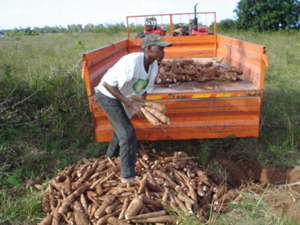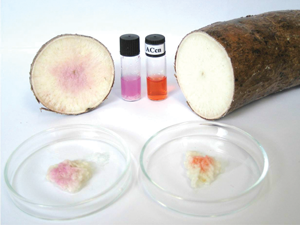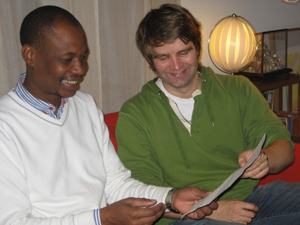Colour changing system indicates if developing world staple is ok to eat

A new sensing system that changes colour to indicate if a cassava-based foodstuff is safe to eat by checking for hydrogen cyanide has been devised by researchers in Switzerland and Mozambique.
Cassava, an edible root that grows well in poor conditions, is the third largest source of calories for people in the tropics. However, as a self-defence mechanism against attack from pests and predators, cassava releases hydrogen cyanide upon damage to its cells. Sun-drying, fermentation and other traditional processing techniques can successfully eliminate the hydrogen cyanide but it may remain and cause a variety of illnesses, including tropical ataxic neuropathy and epidemic spastic paraparesis, if pre-consumption treatment is substandard.

The sensor developed by Felix Zelder from the University of Zurich is based on a cobalt coordinated macrocycle with a similar structure to vitamin B12, called a corrin. Cyanide displaces water molecules coordinated to the corrin resulting in a colour change of orange to violet. Semi-qualitative measurements are possible with a colour chart and the new sensor reacts in seconds, a huge improvement on the usual picrate method, which takes up to 16 hours to detect cyanide and can be imprecise.
Chemosensors expert Vanderlei Machado from the Federal University of Santa Catarina in Brazil says the methodology is very interesting. ‘Other methods are time-consuming, expensive and need the presence of chemists to treat the samples and conduct the analyses.’
As a result of his initial research, Zelder formed a collaboration with Lucas Tivana from Lund University in Sweden, now of Eduardo Mondlane University in Mozambique. Zelder and Tivana adapted the test to rapidly detect cyanide in various cassava products. If cyanide is detected the toxic cassava can then be washed, filtered, retested and eventually used.

Whilst the test is not yet commercially available, the sensor can be easily made from commercial starting materials. Currently it is being made in Zurich, and sent to Africa. The sensor can be used directly in the field by peeling and crushing small pieces of cassava-based food, and mixing the resulting fluid with the chemical sensor.
‘I think there is potential for a cheap single-use test kit if it can be applied to a paper strip or similar materials,’ says Ayyappanpillai Ajayagosh, an expert on molecular probes at the National Institute for Interdisciplinary Science and Technology in India.
Zelder says he now plans to develop and validate a cheap semi-quantitative test-kit and test it in the field and on rural markets. Once developed a short training program for rural farmers and institutional help could result in this sensor being readily available.
References
This article is free to access until 4 December 2014. Downoad it here:
F Zelder and L Tivana, Org. Biomol. Chem., 2014, DOI: 10.1039/c4ob01889c












No comments yet